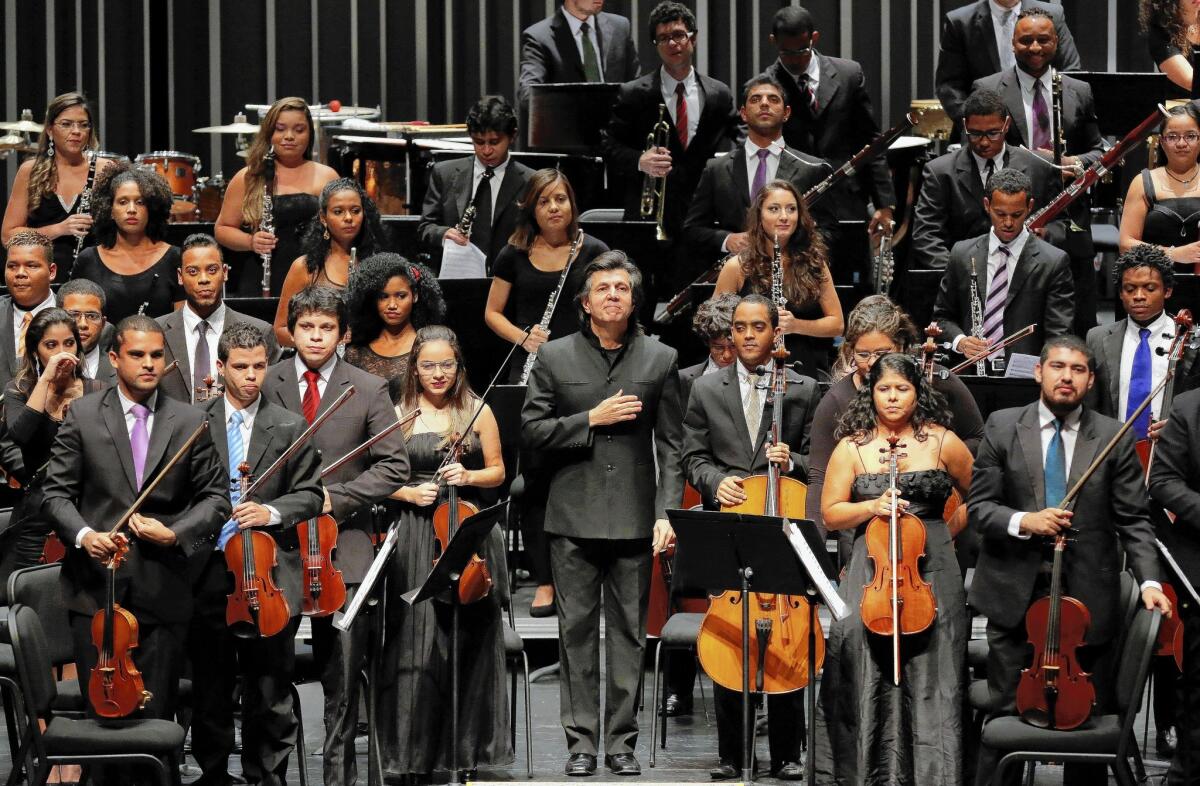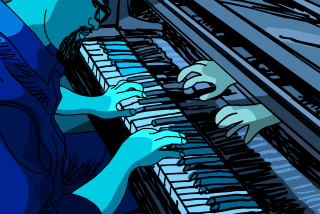Despite Venezuela link, sensational Bahia Orchestra Project of Brazil proves irresistible

Venezuela’s state-supported music education marvel, El Sistema, offering free instruction to nearly 600,000 young people in all corners of the country, is not without controversy.
With an increasingly restive Venezuelan public protesting human rights violations and economic dysfunction, El Sistema, an agency in the executive branch of the government, cannot escape its association with the administration of President Nicolàs Maduro.
But those who argue that El Sistema has always been a program above politics and an example of positive social action that is catching on around the world had powerful evidence with the exceptional Los Angeles debut Wednesday night of the Bahia Orchestra Project. This is an orchestra of young Brazilian musicians directly modeled on El Sistema.
CRITICS’ PICKS: What to watch, where to go, what to eat
Oddly enough, little attention was paid. The concert was modestly attended. There was scant evidence of interest from those putting on or involved with the L.A. Phil’s high-profile “Take a Stand” symposium, being held in conjunction with the TchaikovskyFest and including the participation of L.A.’s own Sistema-style YOLA and HOLA youth orchestra programs.
But in comments that the Bahia orchestra’s music director, Ricardo Castro, made to the audience after the wonderful performances, he said no one had ever had, in the 500-year history of the Bahia region, the idea to start an orchestra until the notion and support came from neighboring Venezuela.
Seven years ago, Castro, a pianist and conductor from Bahia, imported the full Sistema model, and now the Brazilian state has its own Sistema, called NEOJIBA (State Youth and Children’s Orchestra Centers of Bahia), with about 4,000 students and this 140-member Bahia Orchestra Project.
Just like the Bolívars, the Bahia Orchestra is attracting interest from big names. Lang Lang has appeared as a soloist. Pianist Jean-Yves Thibaudet is accompanying the band on this, its first U.S. tour, with concertos by Ravel and Gershwin. The popular Cuban jazz pianist Jesus “Chucho” Valdés was to have been the conductor, but he had to cancel because of an injury, so Castro stepped in.
GRAPHIC: Highest-earning conductors
Thibaudet, then, had a scheduling conflict for Wednesday’s Northridge date, and pianist Stewart Goodyear became a late replacement, substituting Beethoven’s Fifth Piano Concerto (“Emperor”).
All of this proved fortuitous. The Bahia Orchestra is Castro’s project, and he probably should have been leading the tour all along. Goodyear is a phenomenon who deserves wide attention.
I arrived at the concert late, having been told about a shortcut from one of the parking lots at Cal State Northridge and, instead, found myself wandering around the wrong end of the large campus while Bernstein’s “Candide” Overture was being played (another substitution for the originally scheduled “Romeo and Juliet” Fantasy Overture of Tchaikovsky). The “Emperor” had just begun when I was let in to a quiet and fairly empty part of the balcony.
The orchestra sounded scrappy. The ages of the players range from 7 to 29. There was a surprising lightness, even delicacy, to the sound, surprising because it is quite a big ensemble employed for a Beethoven concerto. Intonation was that of students.
But another kind of tuning was ideal, the sense of soloist and orchestra being in tune with each other. Something very special happened.
Goodyear is a kind of pianist outlier. He made his Hollywood Bowl debut a dozen years ago in a Mozart concerto in which he improvised a cadenza. Lately he’s been doing marathons of all 32 piano sonatas —starting at 10 a.m. and finishing at 11:30 p.m. (with lunch and dinner breaks), sometimes accompanied by a dancer.
PHOTOS: Arts and culture in pictures by The Times
He has recently recorded the sonatas, and the performances are airily elegant and excitingly percussive. That was the case in the “Emperor” too. Goodyear’s tone is crisp. He gets the piano to sound like a xylophone. His trills are like bells ringing. The Bahia players tuned into that sound and that airiness with a bright, light, percussive quality that was a touch jazzy and utterly vibrant.
The second half of the program featured the fourth of Villa-Lobos’ “Bachianas Brasileiras” and the 1919 version of Stravinsky’s “Firebird” Suite. Both were sensations. Clearly the orchestra hadn’t had the time to fully rehearse the Beethoven, it being a one-off on the tour.
In the Villa-Lobos, color was everything. Percussion sizzled. The strings swung. The winds were individuals. Alluring melodies took hold and would let go. Principal bassoon Abner da Solva Pinto stood out with a huge sound and a bold personality.
The “Firebird” startled and stirred. Castro went for extremes. He began in the realm of ethereal delicacy. The “Infernal” Dance shook the roof with its powerful accents. The Finale had the captivating sway of a samba. I have never heard a sexier “Firebird.”
The encores were Sistema style, with dancing musicians, in “Aquarela do Brasil,” “Tico Tico” and the Bolívars’ favorite, the Mambo from “West Side Story.”
There is simply no resisting this kind of thing. The complex and troubling argument about Sistema and politics will continue, but kids like these should never be left out of the discussion. I wish more had bothered to hear them.
More to Read
The biggest entertainment stories
Get our big stories about Hollywood, film, television, music, arts, culture and more right in your inbox as soon as they publish.
You may occasionally receive promotional content from the Los Angeles Times.







